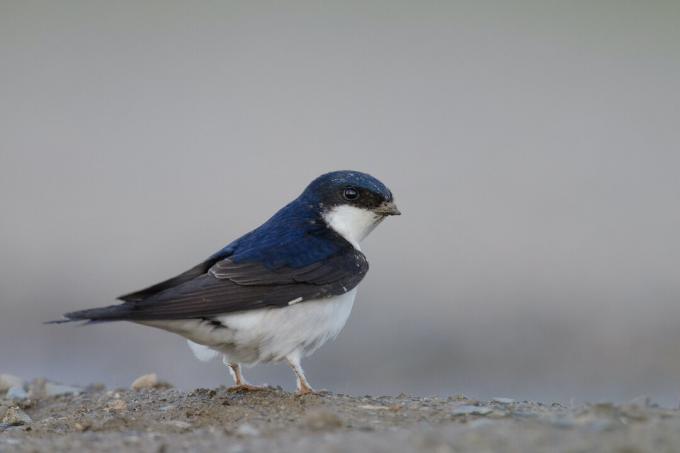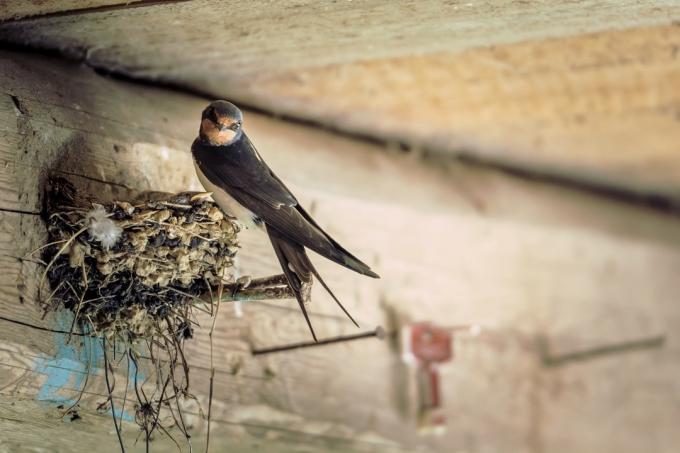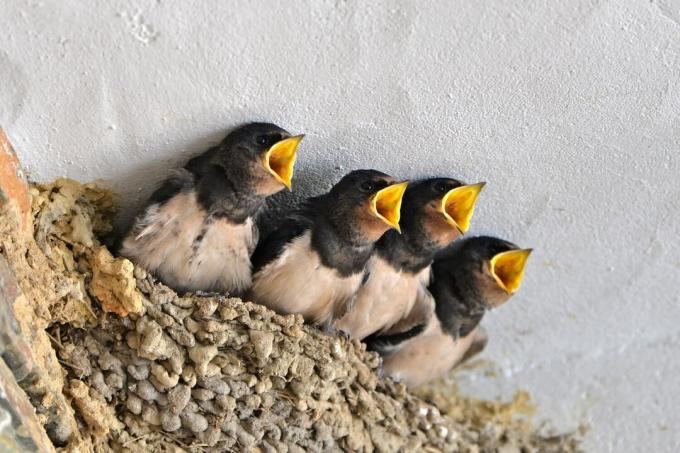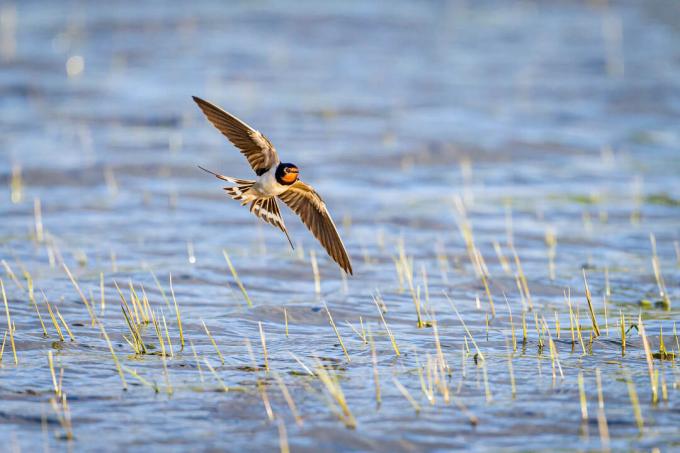What do barn swallows, also known as house swallows, look like? How can you tell them apart from house martins? This article tells you everything you need to know about barn swallows.

The Barn Swallow (Hirundo rustica) is next to the house martin our most common swallow species. The elegant fliers are classic descendants of cultures that have adapted extremely well to human-made habitats. They prefer to find shelter in cattle sheds and barns in rural areas. There they feed on the flying insects above the fields and use puddles of clay on dirt roads to build their nests. However, this idyllic picture has been increasingly unstable for several decades: Small farms are becoming fewer and fewer, dirt roads are being paved and insects are on offer drops drastically. In addition, there are losses due to direct hunting in their African wintering areas. Due to these problems, the population of barn swallows is steadily declining and the former "Bird of the Year 1979" is now on the Red List and classified as endangered. Everything you need to know to identify the native swallows, their breeding biology and possible protective measures can be found in our profile below.
contents
- Barn Swallow: Wanted Poster
-
How do you recognize barn swallows?
- What is the difference between Barn Swallows and House Martins?
- What does the song of barn swallows sound like?
- What do barn swallow chicks look like?
- Where does the barn swallow build its nest?
- How do you recognize barn swallow eggs?
- How to distinguish female and male barn swallows?
- What is your preferred habitat?
- When do barn swallows breed?
- What does the barn swallow do in winter?
-
How can you support Barn Swallows?
- What do barn swallows eat?
- Which nesting aids are suitable for the barn swallow?
- How can you give additional support to barn swallows?
- How can you help barn swallows in need?
Barn Swallow: Wanted Poster
| size | Approximately 17-19cm |
| Weight | About 20g |
| breeding season | May - August |
| lifespan | Up to 8 years |
| habitat | Farms, settlements, cities |
| feed preference | insects |
| threats | lack of food, nesting material and nesting sites; direct tracking |
How do you recognize barn swallows?
Anyone who observes a barn swallow in the sky immediately recognizes the pointed wings and the typical forked tail of the swallow. The latter is characterized by the very long, narrow ends, also called tail spikes, in the barn swallows. In flight, the barn swallow's upper surface and throat appear uniformly dark, while the breast, abdomen, and underwings are in bright contrast. On closer inspection, however, the swallows gleam in a metallic blue-black on top, while the throat is adorned with rust-red feathers that are also shiny metallic.

What is the difference between Barn Swallows and House Martins?
barn swallows and house martins can often be observed together over fields or water. The graceful fliers are sometimes so fast that it is difficult to observe the subtle differences between the species. However, once you have internalized this, it is very easy to determine. First of all, house martins lack the long spiked tails that make barn swallows look so elegant. In addition, the former have a consistently light underside - including the throat. And finally, when house martins are in flight, a brilliant white underside, also called rump, always flashes, which stands in contrast to their otherwise blue-black back.

What does the song of barn swallows sound like?
The song of the barn swallow consists of a lively, unstructured chirp that often ends in a long, dry purr. In flight, similarly cheerful calls can almost always be heard: "Witt-witt-witt".
You can find out what the song of the barn swallow sounds like in this audio recording:
What do barn swallow chicks look like?
Young barn swallows are clearly recognizable by their light underside and dark, blue-black upper side. The throat is also dark in color, which clearly distinguishes it from juvenile house martins. However, they still lack the intense, rust-red throat coloring of the adult animals and the long tail skewers.

Where does the barn swallow build its nest?
Barn Swallows prefer traditional wooden barns and animal pens to build their nests. But they also use other buildings or sheltered building facades. The nests are attached to the vertical wall at the top under the roof. This construction requires a lot of clay and as rough an underground as possible. In the absence of suitable buildings, barn swallows also breed under bridges and make their nests there on the girders.

How do you recognize barn swallow eggs?
Barn Swallow eggs measure an average of 2 x 1.4 centimeters and are white with dark reddish speckles. The females lay four to six eggs in a bowl-shaped nest made of clay and plant fibers, which is lined with fine feathers.
How to distinguish female and male barn swallows?
At first glance, male and female barn swallows look very similar. As so often in the animal kingdom, the males stand out a little more. On average, the female specimens have shorter tail spikes and a less intensely colored throat. The former are more prominent among males because they use them to compete for the attention of females. Long spiked tails express the vitality of the male and are intended to impress the female barn swallows.
What is your preferred habitat?
The ideal habitat for barn swallows consists of a rural region with small-scale cattle sheds and barns, plenty of insects and clay puddles. But barn swallows also feel at home in urban areas if there are suitable buildings or facades as well as suitable natural areas for nesting material and foraging.
When do barn swallows breed?
The barn swallow nesting season begins in May and can extend into August as breeding pairs can raise up to three broods per season under suitable conditions. After laying the eggs, the female incubates the eggs for at least two weeks. The newly hatched young birds are then provided with plenty of insects by their parents and need about 18 to 23 days before they can leave the nest.

What does the barn swallow do in winter?
Barn Swallows do not overwinter in their breeding grounds, but flee to more southern regions. Our native populations spend the cold winter months mainly in Central and South Africa. For the long journey, the barn swallows sometimes form very large swarms in autumn. During this time, it is not uncommon for the birds to be seen crowded in hundreds on trees or power lines.
How can you support Barn Swallows?
In recent decades, barn swallow populations have declined dramatically due to lack of food and nesting opportunities. If you want to support the native birds in your own garden, you will find important tips for a swallow-friendly home here.
What do barn swallows eat?
Barn Swallows are exceptionally good hunters. They catch flying insects from the air and can therefore often be observed in flocks over fields or water surfaces during spectacular flight manoeuvres. Since insects are rather scarce here in winter, the swallows cover large distances in winter to follow the food supply in more southern regions. The classic winter feeding is therefore of no use to this species.

Which nesting aids are suitable for the barn swallow?
Classic closed nest boxes are not suitable for barn swallows. However, there is an option to form cup-shaped, open plaster nests and place them in a barn, shed or on a sheltered part of the facade. It is important to distinguish between flour and barn swallow nests, because most of them are for sale The swallow nesting aids offered are closed hemispheres, except for a small entrance hole, which are only for house martins are suitable.
Whenever possible, however, the barn swallows prefer to make their own nest. But you can also support the birds in their work here. Because suitable nesting material is often a limiting factor, which can lead to unfinished and unstable nests. You can remedy this by offering a small puddle in which the swallows can look for suitable building material containing clay. On the other hand, if your soil is sandy and not very sticky, you can also offer extra loamy, moist soil in a small bowl or in a heap in the garden.
How can you give additional support to barn swallows?
In addition to suitable nesting sites, the food supply is a second major problem for barn swallows. Because the hunters are losing their food base due to the continuing death of insects. If you want to do something good for the swallows at home, you should therefore avoid using chemical sprays in your own garden or when buying groceries. In addition, by creating a flower meadow, you can bring additional life into your home and promote the insect supply in the long term. With our Plantura beneficial insect magnet you can create a wonderful habitat for a variety of small garden dwellers, strengthening the food chain from the bottom up.

Plantura beneficial insect magnet
Annual & perennial species for beneficial insects
such as birds, bees & Co, easier to care for
Blossom dream in bed, pot & window box
How can you help barn swallows in need?
If you find a fledgling outside the nest, there is one thing you should definitely not do: panic. Because there is not always reason to worry. The respective instructions for action depend on both the health and the developmental status of the bird. Young birds fully feathered have probably left the nest of their own accord and, if unharmed, should simply be left alone. Featherless fledglings that are likely to have fallen from the nest should be carefully inspected for injury and, if possible, returned to the nest. If you find injured young animals or cannot locate the nest, you should contact a suitable help center, such as the Wildvogelhilfe, directly.

Of course, the same rules of conduct also apply to all other bird species. And if you want to find out more about native birds, then take a look at our other species portraits star, blackbird or blackcap past.
...and receive concentrated plant knowledge and inspiration directly in your e-mail inbox every Sunday!



